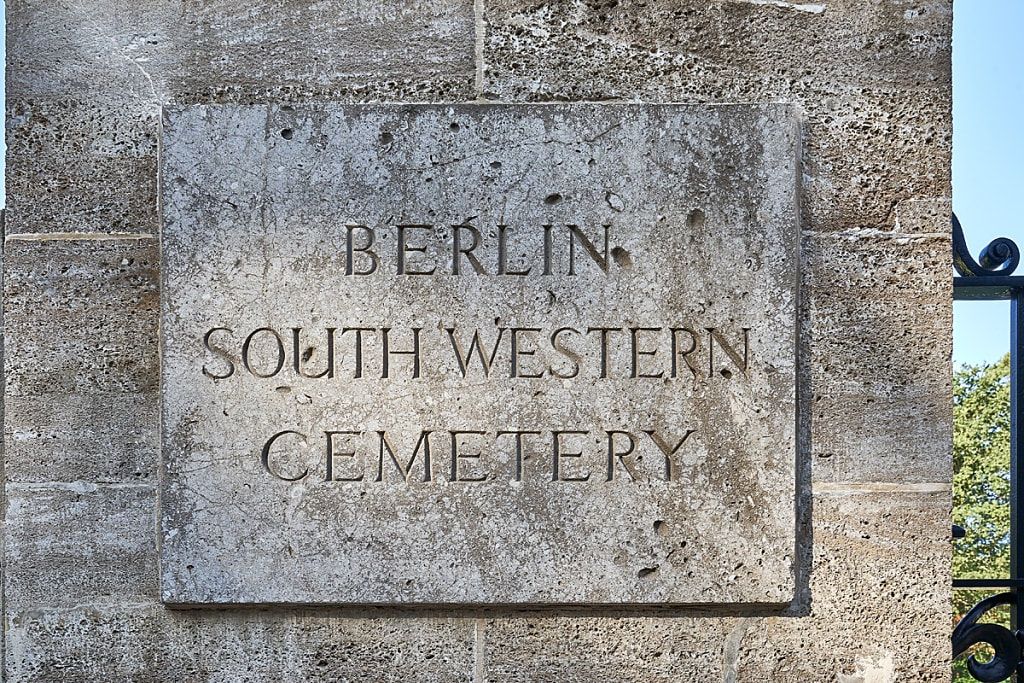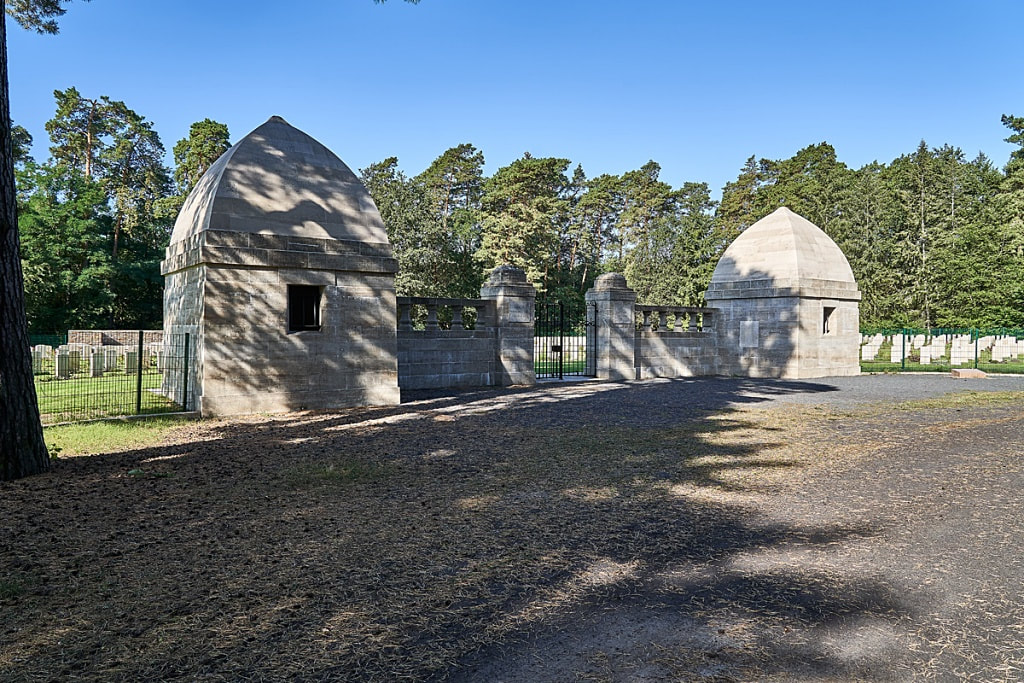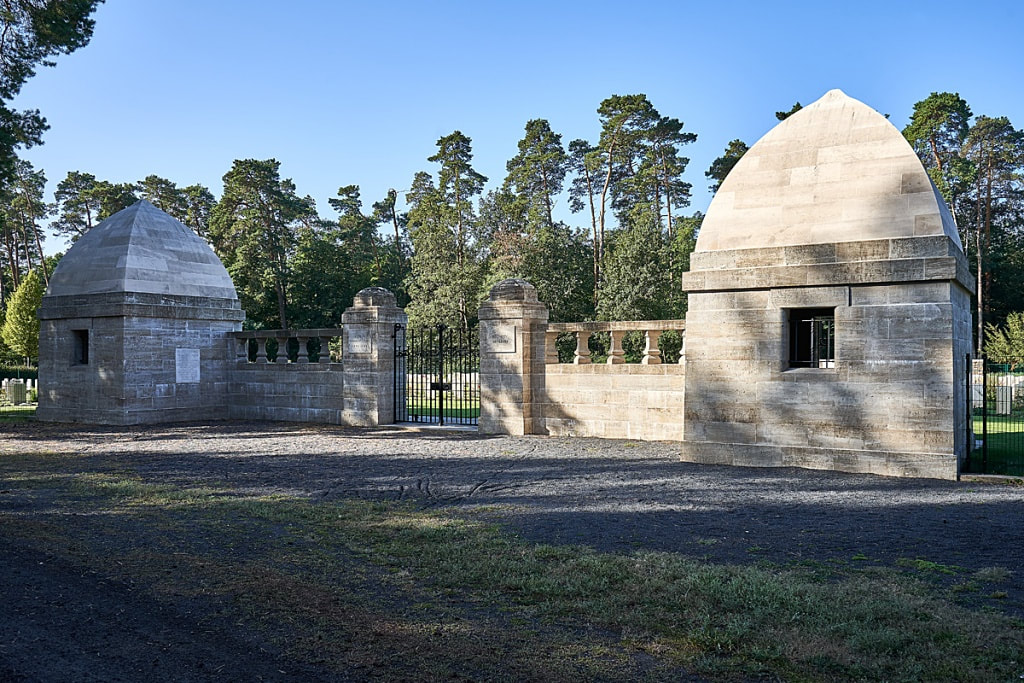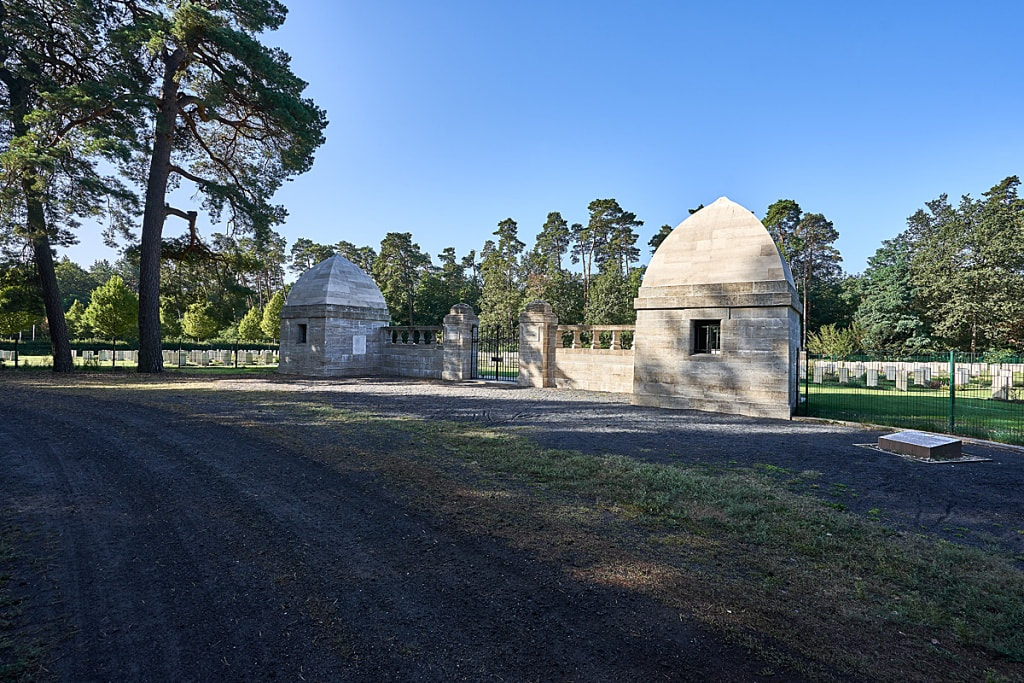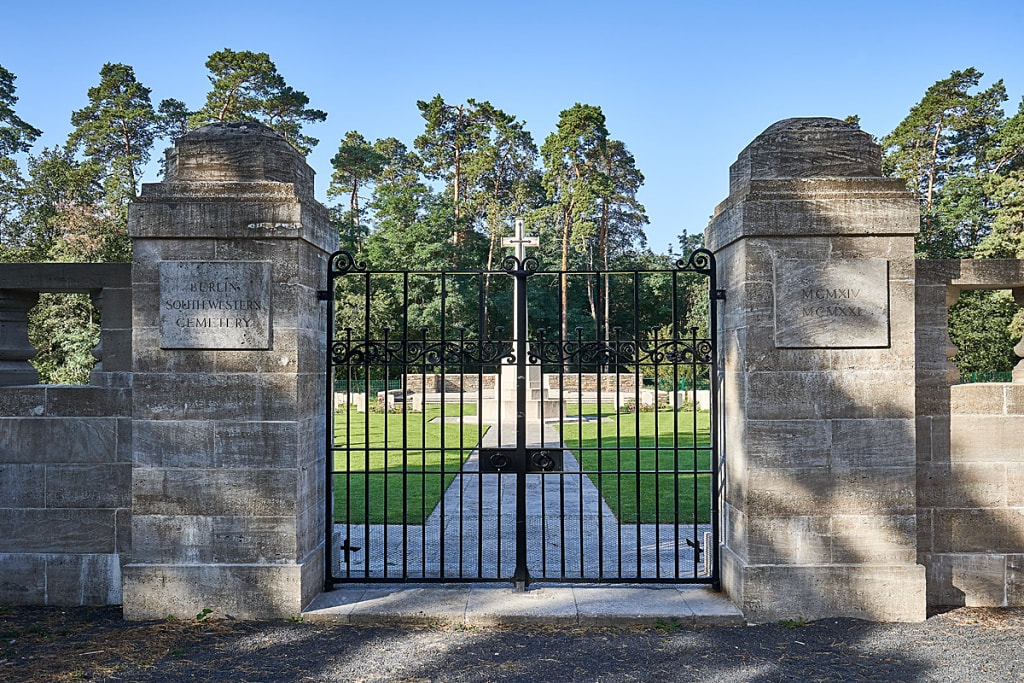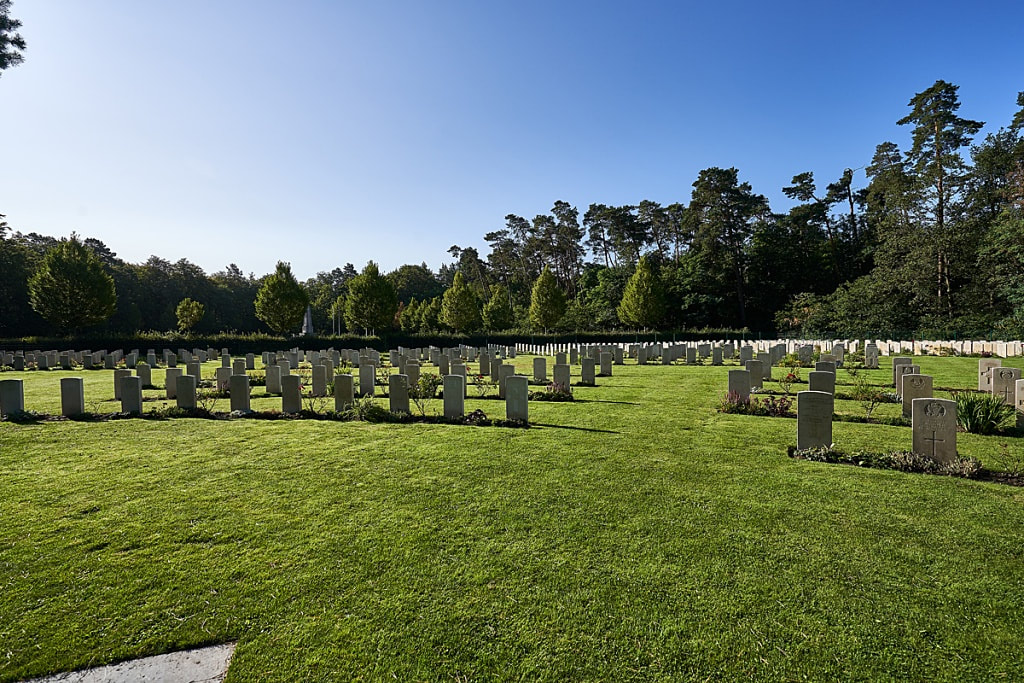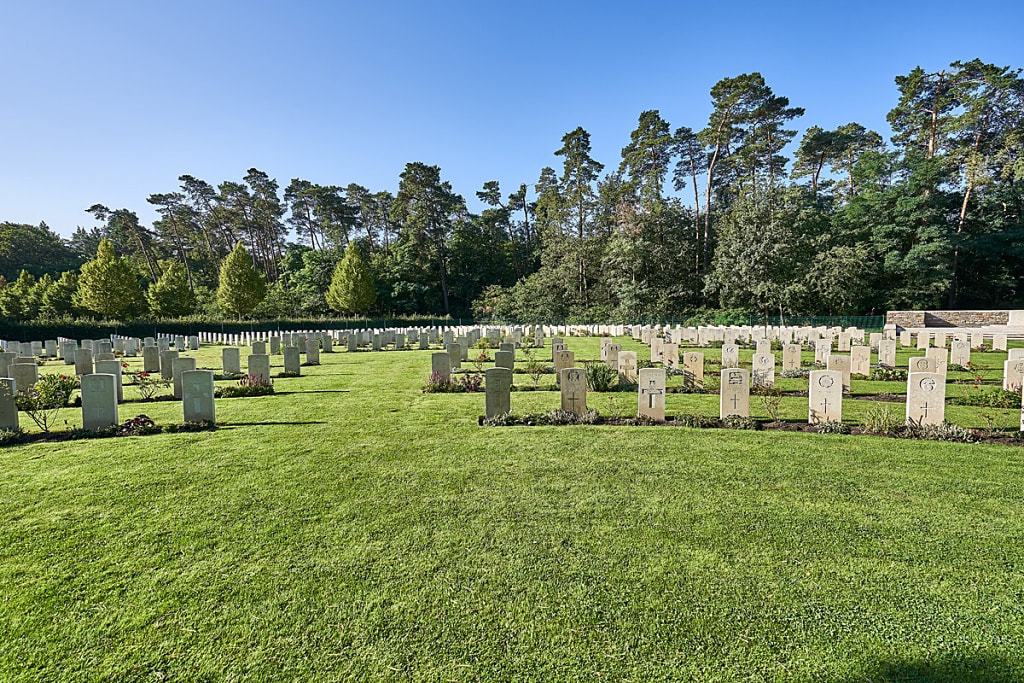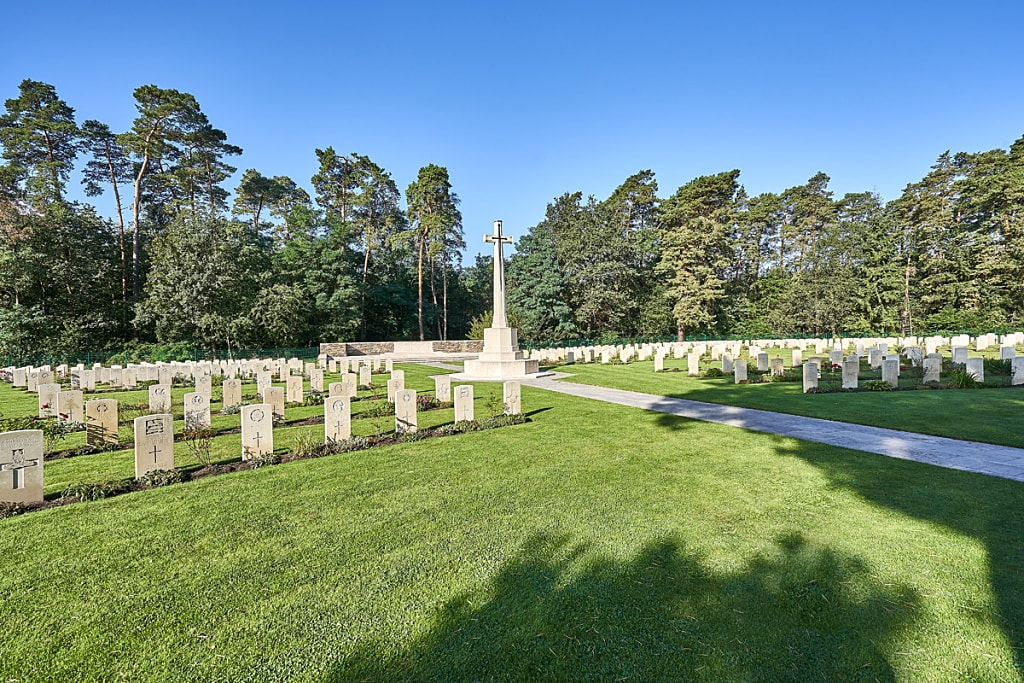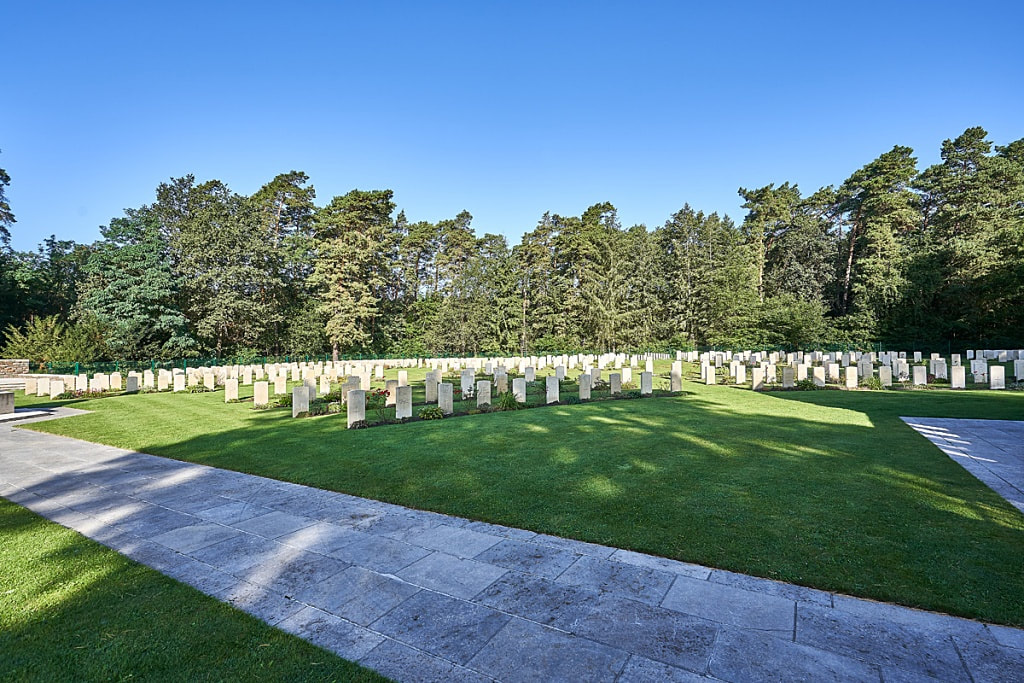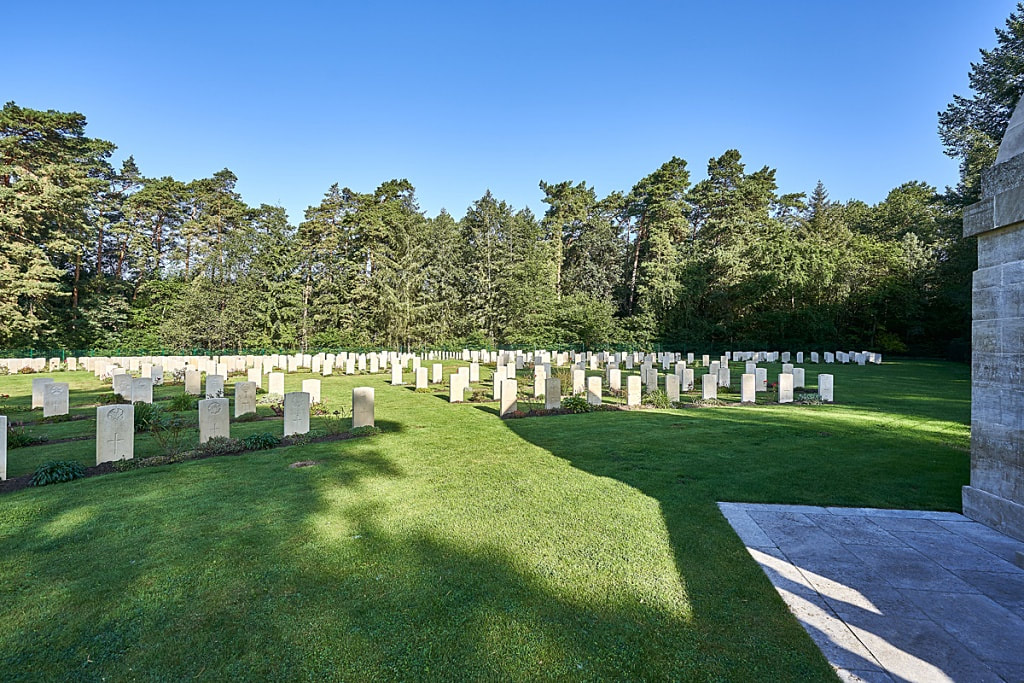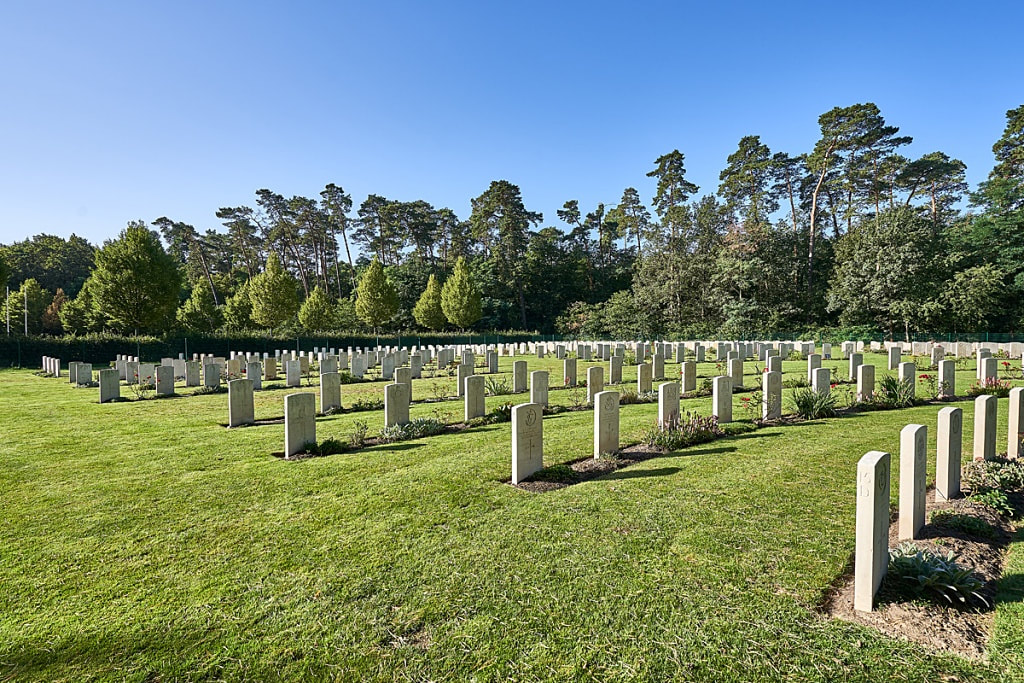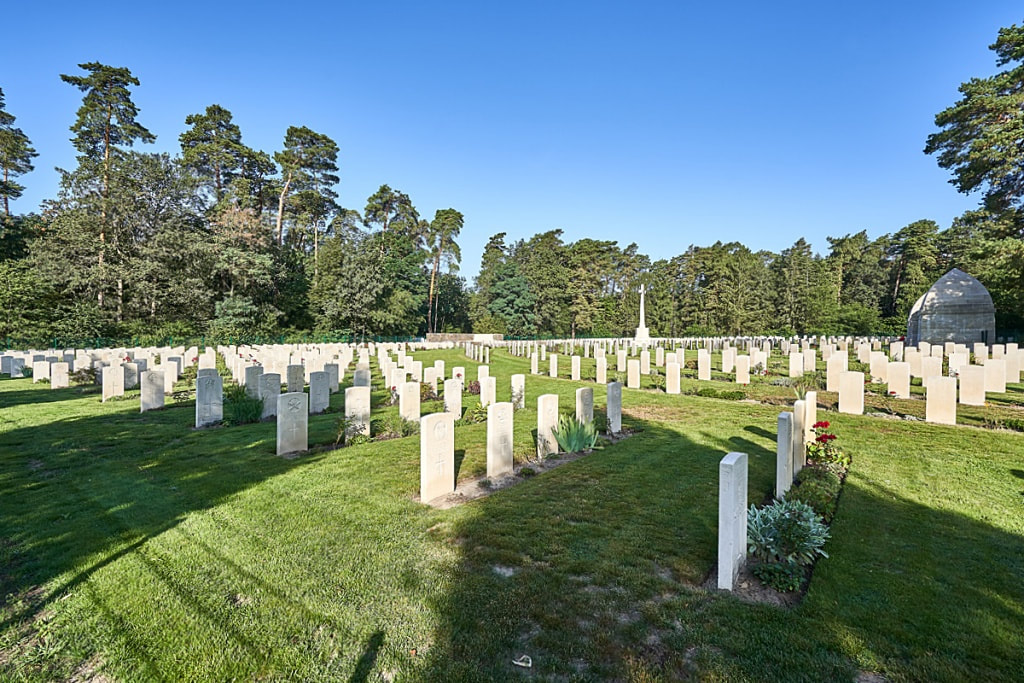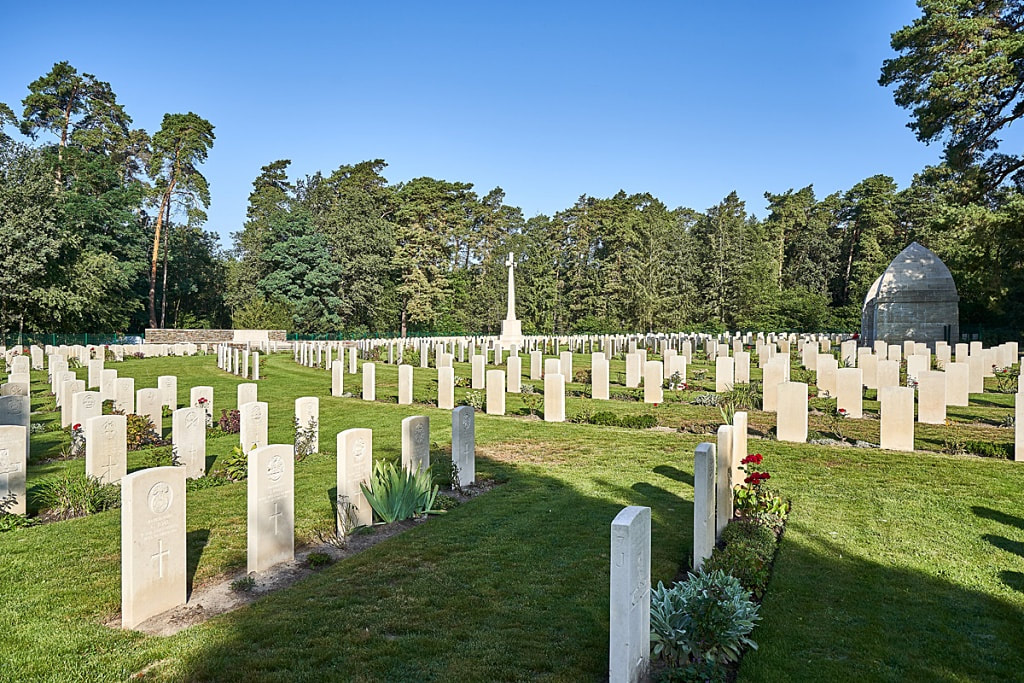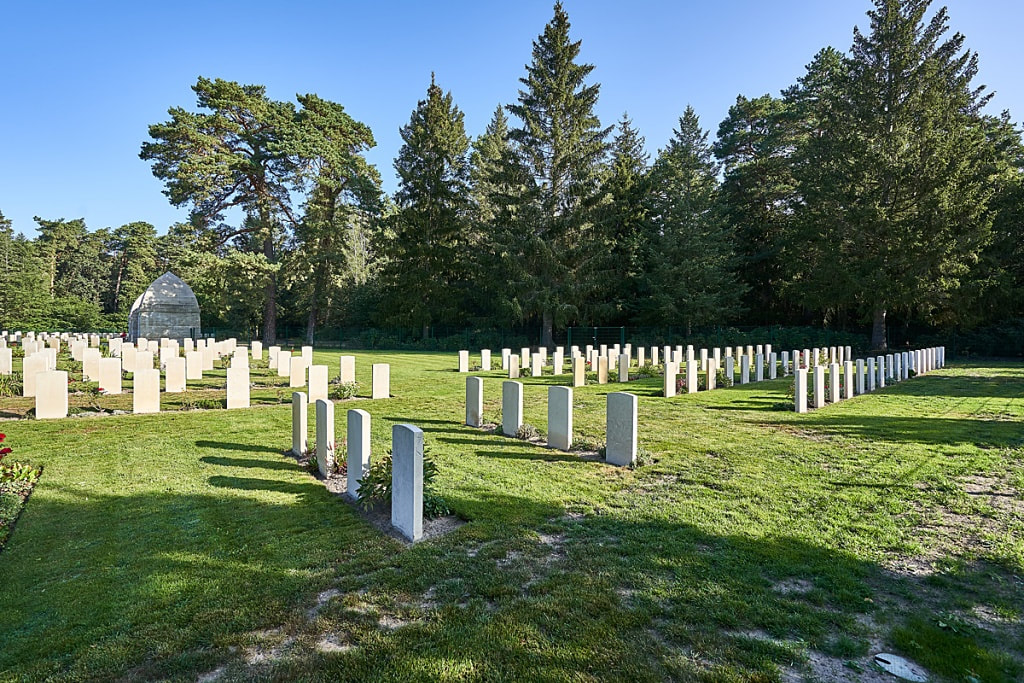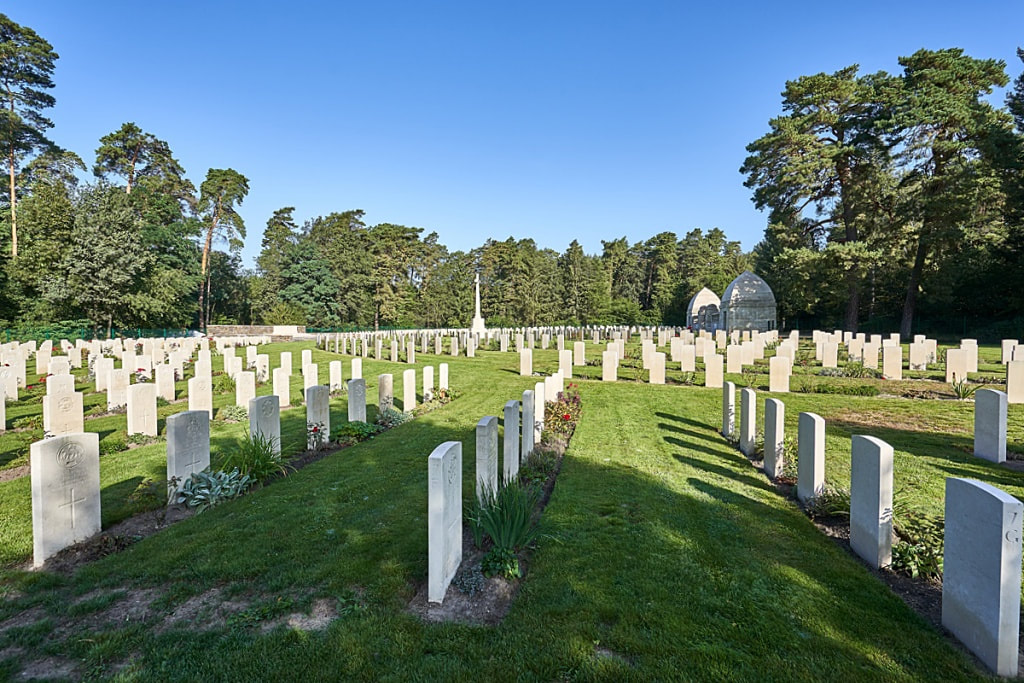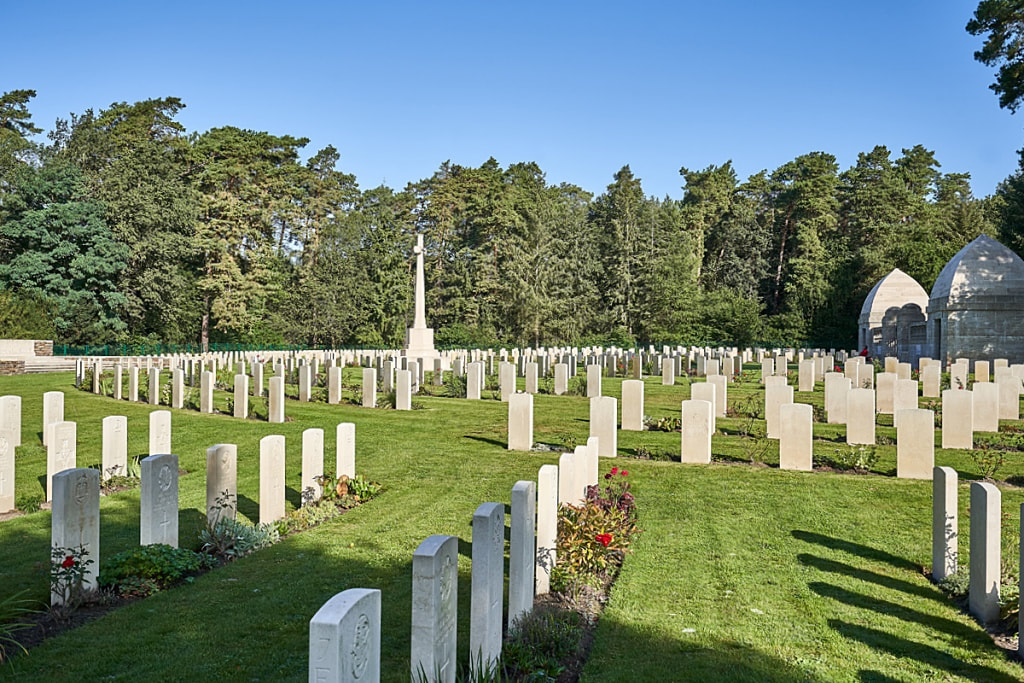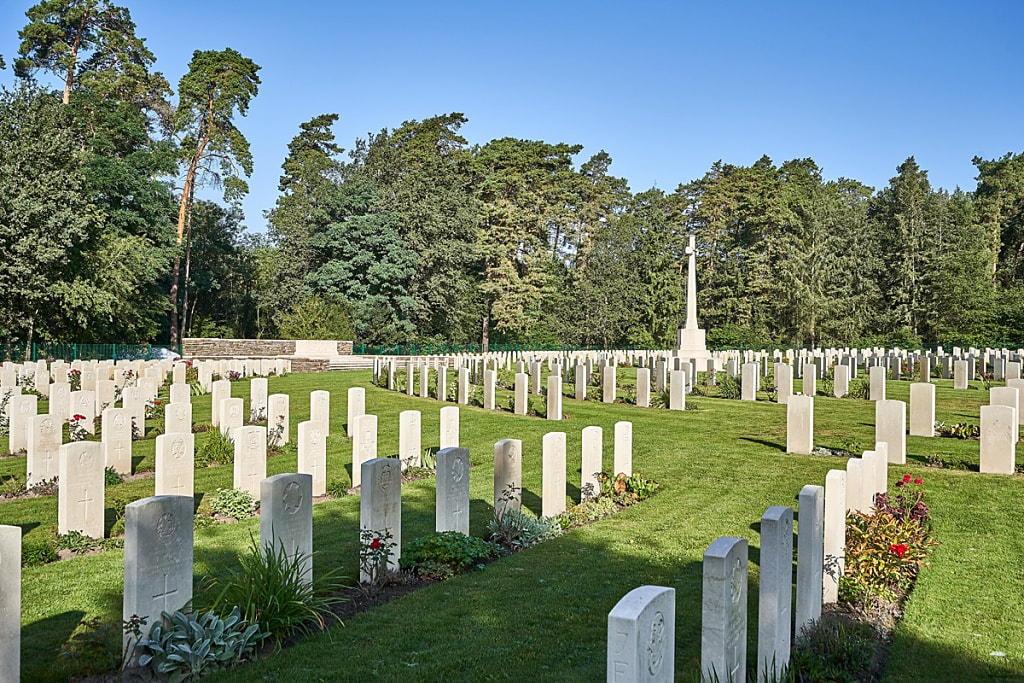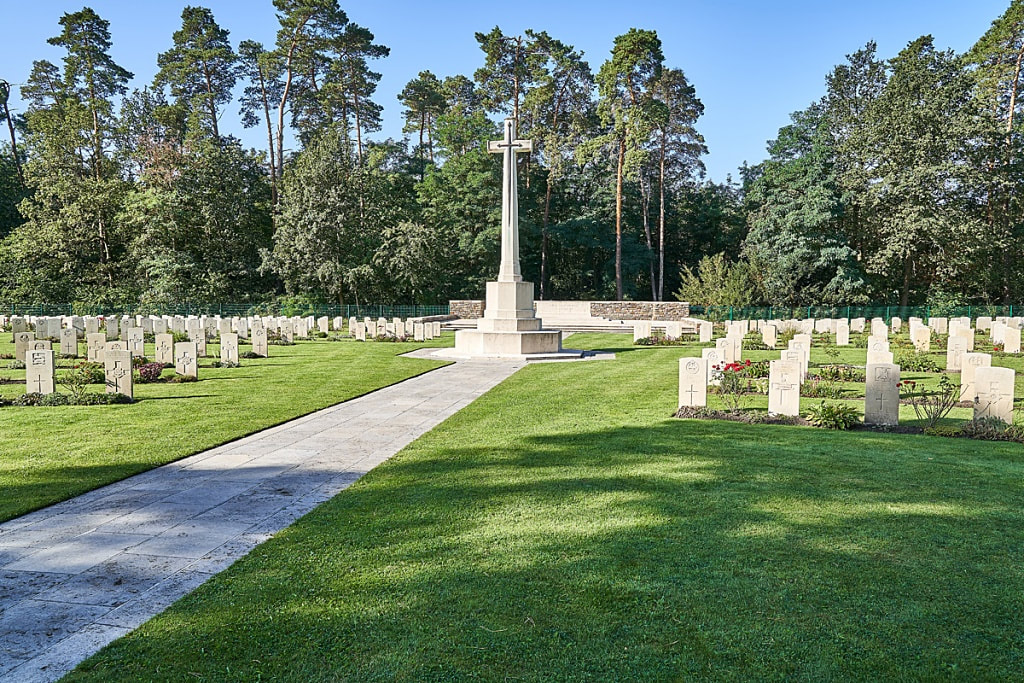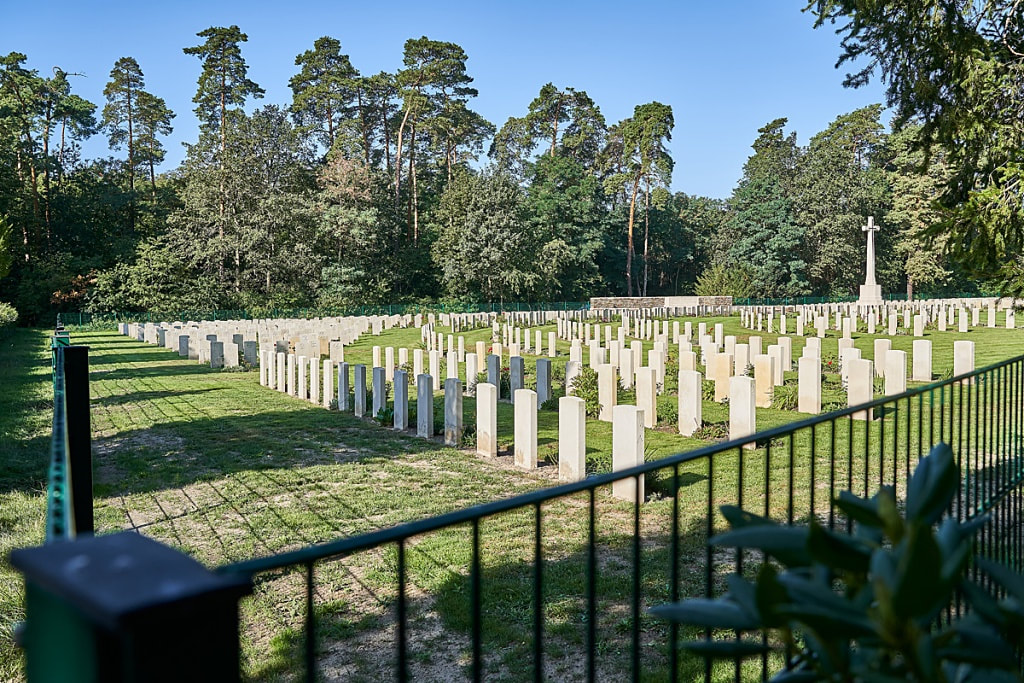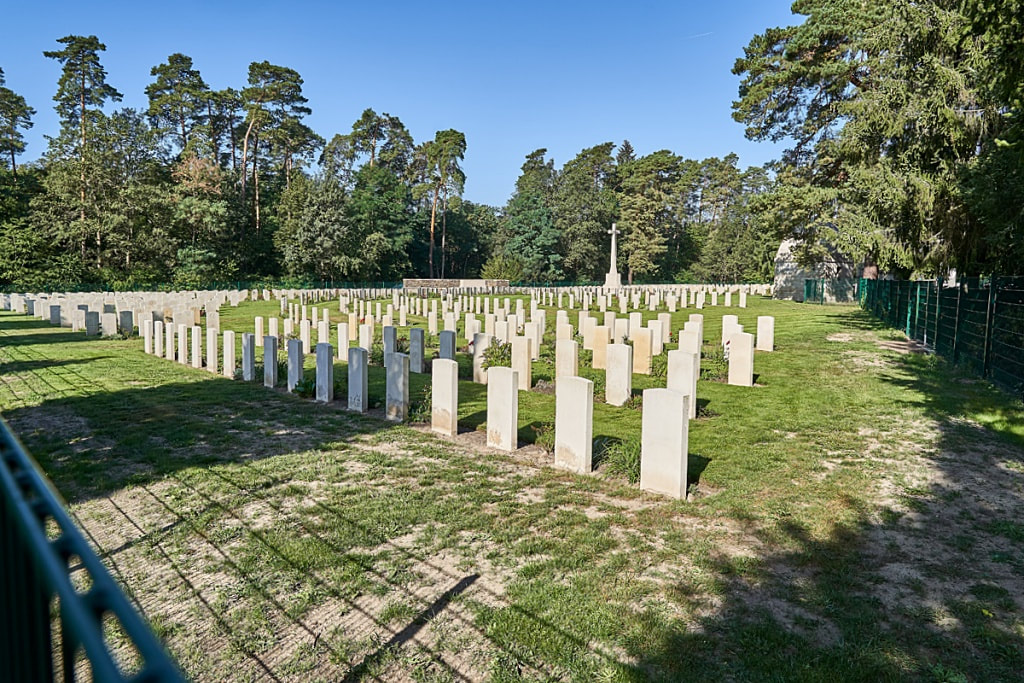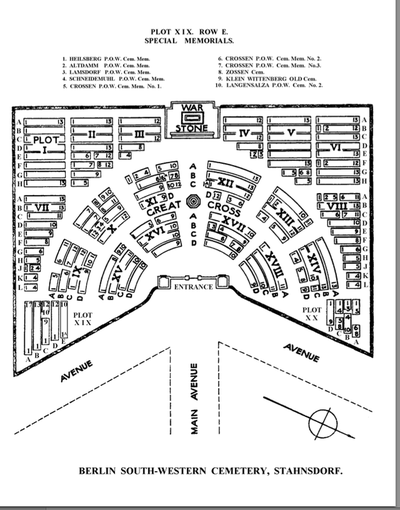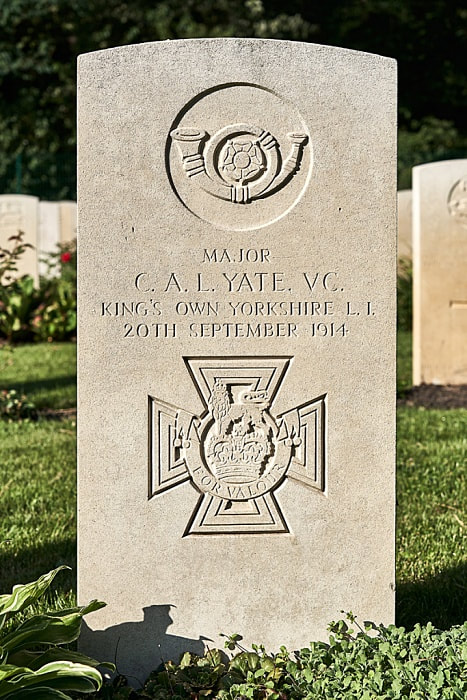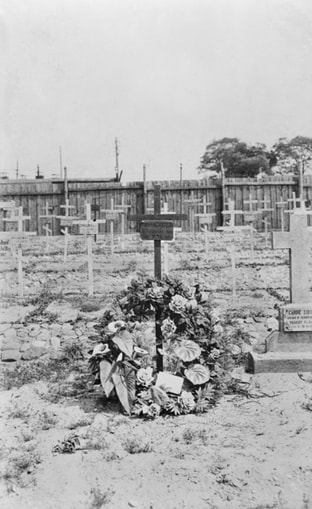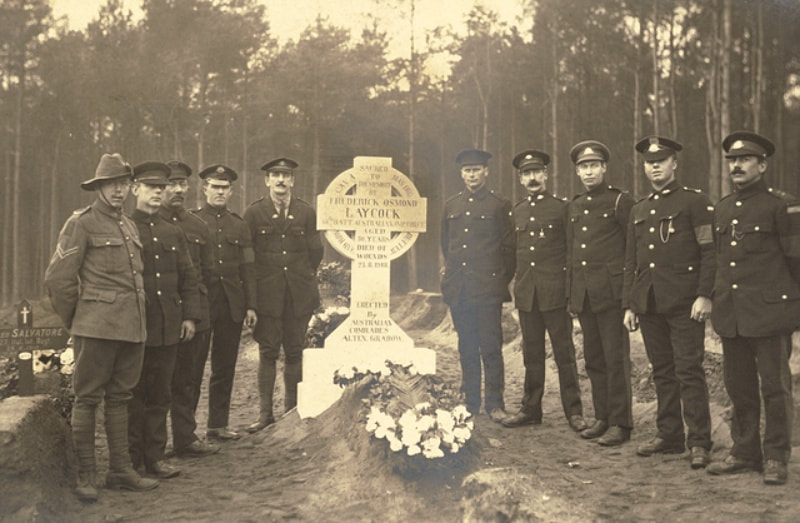BERLIN SOUTH WESTERN CEMETERY
Brandenburg
Germany
Location Information
Berlin is the capital city of Germany and lies in the north east of the country. The village of Stahnsdorf lies approx 22kms south west of Berlin and approx 14kms to the east of Potsdam.
From the A115 motorway take exit 6 (Ausfahrt 6) POTSDAM ZENTRUM / TELTOW.
Follow the signs for TELTOW / STAHNSDORF, and continue for approx 3kms to the village of Stahnsdorf.
Approx 300m after entering the village turn left onto the BAHNHOFSTRASSE.
Continue for approx 500m and the main entrance to the civilian cemetery (Sudwestfriedhof Stahnsdorf) is on the left.
Berlin South-Western Cemetery is approx 1.6kms from the main entrance (20 minutes walk) following the signs for ZUR KAPPELLE. Go past the wooden church on your right and follow the CWGC signpost. The cemetery can be found on the right.
The cemetery address is:-
Sudwestfriedhof
Bahnhofstrasse, 2,
14532 Stahnsdorf
Germany
GPS Co-ordinates: N 52 23 01 E 13 10 32
Visiting Information
visiting hours
1 April - 30 September - 7 to 20 hrs
1 - 31 October - 7 to 18 hrs
1 November - 28 February - 8 to 17 hrs
1 to 31 March - 7 to 18 hrs
Wheelchair access possible via main entrance.
Historical Information
In 1922-23 it was decided that the graves of Commonwealth servicemen who had died all over Germany should be brought together into four permanent cemeteries. Berlin South-Western was one of those chosen and in 1924-25, graves were brought into the cemetery from 146 burial grounds in eastern Germany.
There are now 1,177 First World War servicemen buried or commemorated in the Commonwealth plot at Berlin South-Western Cemetery. The total includes special memorials to a number of casualties buried in other cemeteries in Germany whose graves could not be found.
The following cemeteries are among those from which graves were brought to Berlin South-Western Cemetery:-
ALTDAMM PRISONERS OF WAR CEMETERY, 8 kilometres East of Stettin, in the Province of Pommern (Pomerania), contained the graves of 46 soldiers from the United Kingdom, three from Newfoundland and two from Canada, who died in 1915-1918.
BUDEROSE PRISONERS OF WAR CEMETERY, near Guben, in the Province of Brandenburg, contained the graves of 18 soldiers from the United Kingdom, one from Canada and one from Australia, all of whom died in 1918.
CROSSEN PRISONERS OF WAR CEMETERY, 3 kilometres East of Crossen, on the river Oder, in the Province of Brandenburg, contained the graves of 66 sailors and soldiers from the United Kingdom, one from Australia and one from South Africa all of whom died in 1918.
DOBERITZ PRISONERS OF WAR CEMETERY, about 19 kilometres West of Berlin, in the Province of Brandenburg, contained the graves of 38 sailors and soldiers from the United Kingdom who died in 1914-1918.
HASENHEIDE GARRISON CEMETERY, on the South side of the city of Berlin, contained the graves of 369 Russian, 125 French, and 58 Belgian, American, Italian, Rumanian, Portuguese or Serbian soldiers; 63 sailors, soldiers and Marines from the United Kingdom; and one Indian soldier.
HEILSBERG PRISONERS OF WAR CEMETERY, in Ostpreussen (East Prussia), contained the graves of 50 soldiers and one Marine from the United Kingdom, who died in 1917 and 1918. Only twelve of which were found when the graves were being recovered; the remainder are still buried at Heilsberg.
KLEIN WITTENBERG OLD CEMETERY, 3 kilometres West of Wittenberg, in the Prussian province of Saxony, contained the graves of 23 soldiers, one Marine and eight civilians from the United Kingdom and one soldier from India, all of whom died in 1915; the NEW (or PRISONERS OF WAR) CEMETERY, those of 71 soldiers and three civilians from the United Kingdom, two soldiers from Canada and one from Australia, who died in 1915, 1917 and 1918; and WITTENBERG OLD SMALL CEMETERY those of two soldiers from the United Kingdom who died in 1914 and 1915. The first and third of these cemeteries are associated with the outbreak of typhus at the Wittenberg camp in December 1914.
LAMSDORF PRISONERS OF WAR CEMETERY, in Schlesien (Silesia), contained the graves of 81 soldiers from the United Kingdom, one from Australia and one from New Zealand, who died in 1917-1919 (it was used for French burials in 1870-71).
MAGDEBURG MILITARY CEMETERY, in Prussian Saxony, contained the graves of 24 soldiers and one Marine from the United Kingdom who died in 1915-1918.
MERSEBURG TOWN CEMETERY, in Prussian Saxony, contained the graves of 12 soldiers from the United Kingdom who died in 1914-1917, and the PRISONERS OF WAR CEMETERY those of 33 soldiers from the United Kingdom who died in 1917-1918.
OPPELN TOWN CEMETERY, in Upper Silesia, contained the graves of 41 soldiers from the United Kingdom who died in 1921-22. They belonged to the British force stationed in Upper Silesia during the Plebiscite. Thirty of them, who died after the legal termination of the war, were left buried at Oppeln. SCHNEIDEMUHL PRISONERS OF WAR CEMETERY, in Posen, West Prussia, on the borders of Poland, contained the graves of 76 soldiers from the United Kingdom, five from Australia, three of the Royal Guernsey Light Infantry, and one from Canada, who died in 1915-1918. Eighteen of the graves could not be recovered.
STARGARD PRISONERS OF WAR CEMETERY, in Pomerania, contained the graves of 37 soldiers and one Marine from the United Kingdom, two soldiers from New Zealand and one of the Royal Guernsey Light Infantry, who died in 1917-1918.
STENDAL PRISONERS OF WAR CEMETERY, in Prussian Saxony, contained the graves of 140 soldiers from the United Kingdom, two from Canada and one from Newfoundland, who died in 1917-1918.
ZERBST (HEIDETOR) CEMETERY, in Anhalt, contained the graves of two soldiers from the United Kingdom who died in 1914-1915, and the PRISONERS OF WAR CEMETERY those of 45, who died in 1917-1918.
Total Burials: 1,177.
Identified Casualties: United Kingdom 1,133, Australia 20, Canada 15, South Africa 4, New Zealand 3, India 2. Total 1,177.
Cemetery pictures © Geerhard Joos
Berlin is the capital city of Germany and lies in the north east of the country. The village of Stahnsdorf lies approx 22kms south west of Berlin and approx 14kms to the east of Potsdam.
From the A115 motorway take exit 6 (Ausfahrt 6) POTSDAM ZENTRUM / TELTOW.
Follow the signs for TELTOW / STAHNSDORF, and continue for approx 3kms to the village of Stahnsdorf.
Approx 300m after entering the village turn left onto the BAHNHOFSTRASSE.
Continue for approx 500m and the main entrance to the civilian cemetery (Sudwestfriedhof Stahnsdorf) is on the left.
Berlin South-Western Cemetery is approx 1.6kms from the main entrance (20 minutes walk) following the signs for ZUR KAPPELLE. Go past the wooden church on your right and follow the CWGC signpost. The cemetery can be found on the right.
The cemetery address is:-
Sudwestfriedhof
Bahnhofstrasse, 2,
14532 Stahnsdorf
Germany
GPS Co-ordinates: N 52 23 01 E 13 10 32
Visiting Information
visiting hours
1 April - 30 September - 7 to 20 hrs
1 - 31 October - 7 to 18 hrs
1 November - 28 February - 8 to 17 hrs
1 to 31 March - 7 to 18 hrs
Wheelchair access possible via main entrance.
Historical Information
In 1922-23 it was decided that the graves of Commonwealth servicemen who had died all over Germany should be brought together into four permanent cemeteries. Berlin South-Western was one of those chosen and in 1924-25, graves were brought into the cemetery from 146 burial grounds in eastern Germany.
There are now 1,177 First World War servicemen buried or commemorated in the Commonwealth plot at Berlin South-Western Cemetery. The total includes special memorials to a number of casualties buried in other cemeteries in Germany whose graves could not be found.
The following cemeteries are among those from which graves were brought to Berlin South-Western Cemetery:-
ALTDAMM PRISONERS OF WAR CEMETERY, 8 kilometres East of Stettin, in the Province of Pommern (Pomerania), contained the graves of 46 soldiers from the United Kingdom, three from Newfoundland and two from Canada, who died in 1915-1918.
BUDEROSE PRISONERS OF WAR CEMETERY, near Guben, in the Province of Brandenburg, contained the graves of 18 soldiers from the United Kingdom, one from Canada and one from Australia, all of whom died in 1918.
CROSSEN PRISONERS OF WAR CEMETERY, 3 kilometres East of Crossen, on the river Oder, in the Province of Brandenburg, contained the graves of 66 sailors and soldiers from the United Kingdom, one from Australia and one from South Africa all of whom died in 1918.
DOBERITZ PRISONERS OF WAR CEMETERY, about 19 kilometres West of Berlin, in the Province of Brandenburg, contained the graves of 38 sailors and soldiers from the United Kingdom who died in 1914-1918.
HASENHEIDE GARRISON CEMETERY, on the South side of the city of Berlin, contained the graves of 369 Russian, 125 French, and 58 Belgian, American, Italian, Rumanian, Portuguese or Serbian soldiers; 63 sailors, soldiers and Marines from the United Kingdom; and one Indian soldier.
HEILSBERG PRISONERS OF WAR CEMETERY, in Ostpreussen (East Prussia), contained the graves of 50 soldiers and one Marine from the United Kingdom, who died in 1917 and 1918. Only twelve of which were found when the graves were being recovered; the remainder are still buried at Heilsberg.
KLEIN WITTENBERG OLD CEMETERY, 3 kilometres West of Wittenberg, in the Prussian province of Saxony, contained the graves of 23 soldiers, one Marine and eight civilians from the United Kingdom and one soldier from India, all of whom died in 1915; the NEW (or PRISONERS OF WAR) CEMETERY, those of 71 soldiers and three civilians from the United Kingdom, two soldiers from Canada and one from Australia, who died in 1915, 1917 and 1918; and WITTENBERG OLD SMALL CEMETERY those of two soldiers from the United Kingdom who died in 1914 and 1915. The first and third of these cemeteries are associated with the outbreak of typhus at the Wittenberg camp in December 1914.
LAMSDORF PRISONERS OF WAR CEMETERY, in Schlesien (Silesia), contained the graves of 81 soldiers from the United Kingdom, one from Australia and one from New Zealand, who died in 1917-1919 (it was used for French burials in 1870-71).
MAGDEBURG MILITARY CEMETERY, in Prussian Saxony, contained the graves of 24 soldiers and one Marine from the United Kingdom who died in 1915-1918.
MERSEBURG TOWN CEMETERY, in Prussian Saxony, contained the graves of 12 soldiers from the United Kingdom who died in 1914-1917, and the PRISONERS OF WAR CEMETERY those of 33 soldiers from the United Kingdom who died in 1917-1918.
OPPELN TOWN CEMETERY, in Upper Silesia, contained the graves of 41 soldiers from the United Kingdom who died in 1921-22. They belonged to the British force stationed in Upper Silesia during the Plebiscite. Thirty of them, who died after the legal termination of the war, were left buried at Oppeln. SCHNEIDEMUHL PRISONERS OF WAR CEMETERY, in Posen, West Prussia, on the borders of Poland, contained the graves of 76 soldiers from the United Kingdom, five from Australia, three of the Royal Guernsey Light Infantry, and one from Canada, who died in 1915-1918. Eighteen of the graves could not be recovered.
STARGARD PRISONERS OF WAR CEMETERY, in Pomerania, contained the graves of 37 soldiers and one Marine from the United Kingdom, two soldiers from New Zealand and one of the Royal Guernsey Light Infantry, who died in 1917-1918.
STENDAL PRISONERS OF WAR CEMETERY, in Prussian Saxony, contained the graves of 140 soldiers from the United Kingdom, two from Canada and one from Newfoundland, who died in 1917-1918.
ZERBST (HEIDETOR) CEMETERY, in Anhalt, contained the graves of two soldiers from the United Kingdom who died in 1914-1915, and the PRISONERS OF WAR CEMETERY those of 45, who died in 1917-1918.
Total Burials: 1,177.
Identified Casualties: United Kingdom 1,133, Australia 20, Canada 15, South Africa 4, New Zealand 3, India 2. Total 1,177.
Cemetery pictures © Geerhard Joos
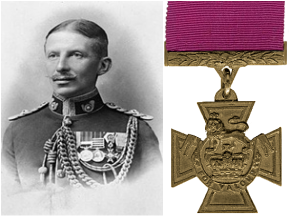
Major Charles Allix Lavington Yate, V. C.
2nd Bn. King's Own Light Infantry, died 20th September 1914, aged 42. Plot II. G. 8.
Son of the Rev. George Edward Yate, Vicar of Madeley, Shropshire and Prebendary of Hereford; husband of Florence Helena. Served in the South African War.
Citation: An extract from "The London Gazette," No. 28985, dated 25th Nov., 1914, records the following:- Commanded one of the two Companies that remained to the end in the trenches at Le Cateau on 26th August, and, when all other officers were killed or wounded and ammunition exhausted, led his nineteen survivors against the enemy in a charge in which he was severely wounded. He was picked up by the enemy and has subsequently died as a prisoner of war
2nd Bn. King's Own Light Infantry, died 20th September 1914, aged 42. Plot II. G. 8.
Son of the Rev. George Edward Yate, Vicar of Madeley, Shropshire and Prebendary of Hereford; husband of Florence Helena. Served in the South African War.
Citation: An extract from "The London Gazette," No. 28985, dated 25th Nov., 1914, records the following:- Commanded one of the two Companies that remained to the end in the trenches at Le Cateau on 26th August, and, when all other officers were killed or wounded and ammunition exhausted, led his nineteen survivors against the enemy in a charge in which he was severely wounded. He was picked up by the enemy and has subsequently died as a prisoner of war
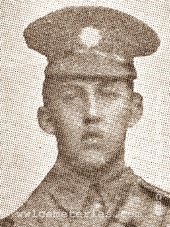
7630 Guardsman
Henry Balderstone
2nd Bn. Coldstream Guards
Died as a Prisoner of War, 17th August 1915.
Plot IX. A. 8.
Son of Mrs. Cecily Balderstone, of 29, Stanley St., Colne, Lancs.
Henry Balderstone
2nd Bn. Coldstream Guards
Died as a Prisoner of War, 17th August 1915.
Plot IX. A. 8.
Son of Mrs. Cecily Balderstone, of 29, Stanley St., Colne, Lancs.
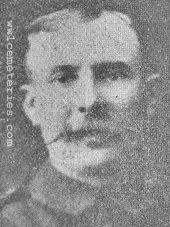
3260 Private
John Cassidy
1st Bn. Loyal North Lancashire Regiment
Died as a Prisoner of War, 16th February 1915, aged 40.
Plot XIX. D. 1.
Son of Jim Cassidy, of Liverpool; husband of Margaret Arm Cassidy, of 2, Charlotte St., Burnley.
John Cassidy
1st Bn. Loyal North Lancashire Regiment
Died as a Prisoner of War, 16th February 1915, aged 40.
Plot XIX. D. 1.
Son of Jim Cassidy, of Liverpool; husband of Margaret Arm Cassidy, of 2, Charlotte St., Burnley.
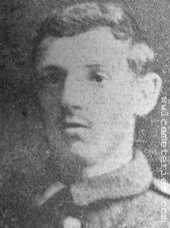
58764 Private
Harold Cocker
17th Liverpool Regiment
22nd March 1918, aged 26.
Plot I. D. 1.
Husband of Mrs. L. G. Cocker, of 115, Cog Lane, Burnley.
Harold Cocker
17th Liverpool Regiment
22nd March 1918, aged 26.
Plot I. D. 1.
Husband of Mrs. L. G. Cocker, of 115, Cog Lane, Burnley.
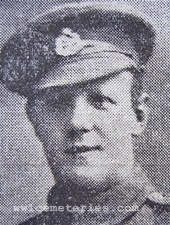
55023 Lance/Corporal
William Baldwin Dixon
17th Bn. Manchester Regiment
Died 11th July 1918 of Pneumonia
in a German Hospital, aged 27.
Plot I. E. 4.
Son of James and Jane Dixon.
William Baldwin Dixon
17th Bn. Manchester Regiment
Died 11th July 1918 of Pneumonia
in a German Hospital, aged 27.
Plot I. E. 4.
Son of James and Jane Dixon.
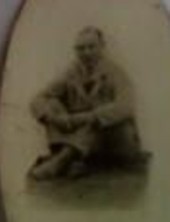
30036 Private
Joseph Ferguson
1st Bn. East Yorkshire Regiment.
16th June 1918.
Plot VI. A. 10.
Picture courtesy of Angela Brown, Great niece of this soldier.
Joseph Ferguson
1st Bn. East Yorkshire Regiment.
16th June 1918.
Plot VI. A. 10.
Picture courtesy of Angela Brown, Great niece of this soldier.

40123 Private
Daniel Flynn
11th Bn. Lancashire Fusiliers
Died of Wounds 1st May 1918 in Stendale Hospital Germany, aged 30.
Plot I. F. 10.
Lived at 8 Hill Top Passage, Burnley, Lancashire.
Daniel Flynn
11th Bn. Lancashire Fusiliers
Died of Wounds 1st May 1918 in Stendale Hospital Germany, aged 30.
Plot I. F. 10.
Lived at 8 Hill Top Passage, Burnley, Lancashire.
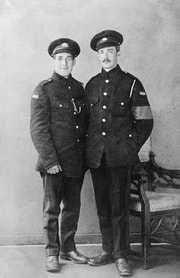
903 Private
Benjamin Joseph Gannaway
11th Bn. Australian Infantry, A. I. F.
Died between 4th November 1918 and 5th November 1918.
Plot V. C. 7.
Click on image to enlarge
Studio portrait of two Australian Prisoners of War (POW) at Altdamm, Germany (now Poland). Identified on left is 903 Private (Pte) Benjamin Joseph Gannaway, from Wagin, Western Australia, and on right is 3903 Pte Melbourne Hubert Randolph Matthews, from Perth, Western Australia, both of the 11th Battalion. Pte Gannaway enlisted at the age of 29 on 27 August 1914 and embarked for overseas on 2 November 1914 aboard HMAT Ascanius. He was wounded in action at Gallipoli but recovered from the gun shot wound to his arm and went on to serve on the Western Front. He was captured at Lagnicourt, France, on 15 April 1917 and held in a number of different POW camps in Germany. On 8 September 1917 he wrote from Friedrichsfeld "Have had another move, last place I was working for the Commandant building a large ... shed. Most of us working here in a large timber mill. The food is much better and work not so hard." Pte Gannaway died of influenza on 4 November 1918 and was buried at the Garrison Cemetery Stettin. He was later re-interred at the South Western Cemetery at Stahnsdorf, Berlin. Pte Matthews enlisted at the age of 20 on 30 August 1915 and embarked for overseas on 22 November 1915 aboard RMS Mongolia. He was captured at Fleuricourt, France, on 16 April 1917 and held as a POW until repatriated to England on 15 December 1918. Pte Matthews arrived back in Australia on 17 March 1919.
Benjamin Joseph Gannaway
11th Bn. Australian Infantry, A. I. F.
Died between 4th November 1918 and 5th November 1918.
Plot V. C. 7.
Click on image to enlarge
Studio portrait of two Australian Prisoners of War (POW) at Altdamm, Germany (now Poland). Identified on left is 903 Private (Pte) Benjamin Joseph Gannaway, from Wagin, Western Australia, and on right is 3903 Pte Melbourne Hubert Randolph Matthews, from Perth, Western Australia, both of the 11th Battalion. Pte Gannaway enlisted at the age of 29 on 27 August 1914 and embarked for overseas on 2 November 1914 aboard HMAT Ascanius. He was wounded in action at Gallipoli but recovered from the gun shot wound to his arm and went on to serve on the Western Front. He was captured at Lagnicourt, France, on 15 April 1917 and held in a number of different POW camps in Germany. On 8 September 1917 he wrote from Friedrichsfeld "Have had another move, last place I was working for the Commandant building a large ... shed. Most of us working here in a large timber mill. The food is much better and work not so hard." Pte Gannaway died of influenza on 4 November 1918 and was buried at the Garrison Cemetery Stettin. He was later re-interred at the South Western Cemetery at Stahnsdorf, Berlin. Pte Matthews enlisted at the age of 20 on 30 August 1915 and embarked for overseas on 22 November 1915 aboard RMS Mongolia. He was captured at Fleuricourt, France, on 16 April 1917 and held as a POW until repatriated to England on 15 December 1918. Pte Matthews arrived back in Australia on 17 March 1919.
Grave of 5810 Private (Pte) William Francis Henderson, 18th Battalion from Sydney NSW. A large wreath is propped up against the simple black cross amongst all the white crosses for the Germany soldiers. Pte Henderson enlisted at the age of 18 on 26 June 1916 and embarked for overseas on 7 October 1916 aboard HMAT Ceramic. He was captured at Bullecourt, France on 15 April 1917 and held as a POW in Germany. Pte Henderson died of dysentery at Wittenberg, Germany on 16 August 1917. In 1925 his body was exhumed from the Wittenberg POW cemetery and re-interred in the Berlin South Western Cemetery, Stahnsdorf, Germany.
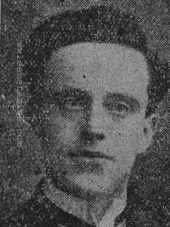
25418 Private
Edward James Jordan
8th Bn. Border Regiment
Died as a Prisoner of War
8th November 1918, aged 27.
Plot II. E. 3.
Son of Edward and Chartlotte Jordan; husband of Annie Jordan, of 54, Milton St. Burnley.
Edward James Jordan
8th Bn. Border Regiment
Died as a Prisoner of War
8th November 1918, aged 27.
Plot II. E. 3.
Son of Edward and Chartlotte Jordan; husband of Annie Jordan, of 54, Milton St. Burnley.
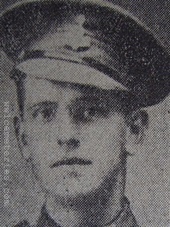
202703 Private
Francis Meshack Jowett
1/4th Bn. Alexandria (Prince of Wales own) Yorkshire Regiment
Died as a Prisoner of War, 28th October 1918.
Plot XVI. B. 2.
Lived on Mosley Street, Burnley, Lancashire
Francis Meshack Jowett
1/4th Bn. Alexandria (Prince of Wales own) Yorkshire Regiment
Died as a Prisoner of War, 28th October 1918.
Plot XVI. B. 2.
Lived on Mosley Street, Burnley, Lancashire
Group portrait of Prisoners of War (POW) standing beside a grave at the Alten Grabow POW camp, Germany. The elaborate headstone bears the inscription “Sacred to the memory of Frederick Osmond Laycock 48th Batt. Australian Imp. Force Aged 30 Years Died of Wounds 23.8.1918 Erected by Australian Comrades Alten. Grabow.” Inscribed in the circle around the cross is “And how can a man die better”. 3413 Private (Pte) Frederick Osmond Laycock, from Gawler, South Australia, enlisted at the age of 30 on 11 November 1916 and embarked for overseas on 10 February 1917 aboard HMAT Seang Bee. He was wounded and captured at Albert, France, on 3 April 1918 and held as a POW in Germany. Pte Laycock died on 23 August 1918 following an operation to remove a bullet from his back. In 1925 his parents were advised that his body had been exhumed from Alten Grabow POW Cemetery and re-interred in the Berlin South Western Cemetery with a permanent headstone of uniform design. Identified standing third from the right is 2694 Pte Robert Hugh Leister, 53rd Battalion from Parkes, NSW who enlisted at the age of 23 on 17 April 1916 and embarked for overseas on 7 October 1916 aboard HMAT Ceramic. He was reported wounded and missing on 31 March 1917 and later confirmed as a POW. After repatriation to England on 10 January 1919 he reported to the Red Cross "Awaiting transference to Southall. Suffering from gun shot wound in left leg. Up and about.” Pte Leister arrived back in Australia on 10 June 1919.
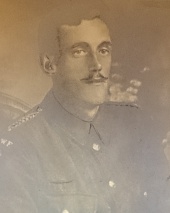
3952 Private
Percy Lucas
1st Bn., Royal Welsh Fusiliers
26th February 1915, aged 22.
Plot XIX. D. 4.
Son of Mr. and Mrs. William Lucas, of Silver Bank, St. Asaph, Flintshire.
Born Stottesdon, Shropshire 16th October1891. Lived with his parents William and Ann lucas, at Silver bank, Mill street. St. Asaph North Wales. A pre war special reservist with 3rd R. W. F. and an R. A. C. guide. Went to France on 2nd Nov 1914, missing Dec 3rd 1914. Died of typhus at Klein Wittenberg prisoner of war camp 22nd Feb 1915. His older brother William Charles Lucas also died during the war and is buried in the local churchyard at St. Asaph.
Picture and information provided by Matthew Lucas (Great Nephew)
Percy Lucas
1st Bn., Royal Welsh Fusiliers
26th February 1915, aged 22.
Plot XIX. D. 4.
Son of Mr. and Mrs. William Lucas, of Silver Bank, St. Asaph, Flintshire.
Born Stottesdon, Shropshire 16th October1891. Lived with his parents William and Ann lucas, at Silver bank, Mill street. St. Asaph North Wales. A pre war special reservist with 3rd R. W. F. and an R. A. C. guide. Went to France on 2nd Nov 1914, missing Dec 3rd 1914. Died of typhus at Klein Wittenberg prisoner of war camp 22nd Feb 1915. His older brother William Charles Lucas also died during the war and is buried in the local churchyard at St. Asaph.
Picture and information provided by Matthew Lucas (Great Nephew)
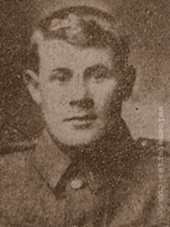
3336 Private
Henry Ryan
2nd Bn. East Lancashire Regiment
Died as a Prisoner of War, 19th September 1918.
Plot X. D. 11.
Lived at Lower Dam Fields, Cliviger, Burnley Lancashire.
Husband of Mrs. E. A. Hollings (formerly Ryan), of 15, Longfield Terrace, Cliviger, Burnley, Lancashire.
Henry Ryan
2nd Bn. East Lancashire Regiment
Died as a Prisoner of War, 19th September 1918.
Plot X. D. 11.
Lived at Lower Dam Fields, Cliviger, Burnley Lancashire.
Husband of Mrs. E. A. Hollings (formerly Ryan), of 15, Longfield Terrace, Cliviger, Burnley, Lancashire.
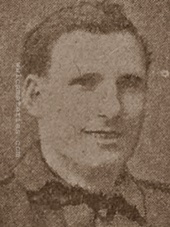
6742 Private
Charles Smith
1st Bn. East Lancashire Regiment
Murdered by his German Captors, 30th July 1918, aged 33.
Plot V. F. 9.
Brother of Miss E. Smith, of 27, Richard St., Fulledge, Burnley, Lancashire.
Charles Smith
1st Bn. East Lancashire Regiment
Murdered by his German Captors, 30th July 1918, aged 33.
Plot V. F. 9.
Brother of Miss E. Smith, of 27, Richard St., Fulledge, Burnley, Lancashire.
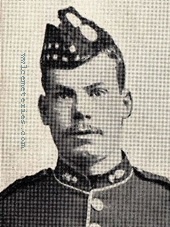
6858 Private
Albert Edward Wickes
1st Bn. Royal Scots Fusiliers
14th March 1915, aged 35.
Plot XIX. D. 12.
Husband of Ruth Wickes, of 25, Carlton St., Brierfield, Burnley.
Albert Edward Wickes
1st Bn. Royal Scots Fusiliers
14th March 1915, aged 35.
Plot XIX. D. 12.
Husband of Ruth Wickes, of 25, Carlton St., Brierfield, Burnley.

